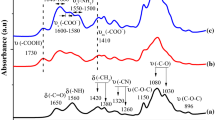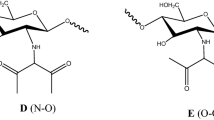Abstract
Hexavalent chromium is a highly toxic metal that can enter drinking water sources. Chitosan, which contains amino and hydroxyl functional groups, is considered an appropriate candidate to remove heavy metals through absorption. In this study, a novel adsorbent, magnetic nanoparticles of chitosan modified with polyhexamethylene biguanide (Ch-PHMB NPs) was synthesized and was used to successfully remove chromium from aqueous solution. Quadratic models with independent variables including pH, adsorbent dosage, time, and the initial concentration of chromium were proposed through RSM to describe the behavior of both magnetic chitosan (M-Ch) and Ch-PHMB NPs in Cr(VI) removal. Optimized models with adjusted R2 values of 0.8326 and 0.74 for M-Ch and Ch-PHMB NPs were developed. Cr(VI) removal from aqueous solution by both absorbents followed pseudo-second-order kinetics. The experimental data were best fitted to the Temkin and Freundlich models for M-Ch and Ch-PHMB NPs, respectively. M-Ch and Ch-PHMB NPs can effectively remove the hexavalent chromium from aqueous solution with pH above 7. Ch-PHMB NPs have higher removal efficiency than M-Ch, removing up to 70% of Cr(VI) from aqueous solution. However, toxicity evaluation on Daphnia magna revealed that Ch-PHMB NPs was more toxic than M-Ch nanoparticles.











Similar content being viewed by others
Abbreviations
- BET:
-
Brunauer–Emmett–Teller
- C0 :
-
Initial concentration of chromium solution
- Ce :
-
Equilibrium concentration of chromium solution
- CCD:
-
Central composite design
- Ch-PHMB:
-
Magnetic nanoparticles of chitosan modified with PHMB.
- D. magna :
-
Daphnia magna
- FTIR:
-
Fourier-transform infrared spectroscopy
- LOF:
-
Lack of fit
- M-Ch:
-
Magnetic chitosan
- NPs:
-
Nanoparticles
- PHMB:
-
Polyhexamethylene biguanide
- RSM:
-
Response surface methodology
- SEM:
-
Scanning electron microscope
- TGA:
-
Thermogravimetric analysis
- V:
-
Volume of chromium solution
- W:
-
Weight of the adsorbent
- X1 :
-
pH (dimensionless)
- X2 :
-
Adsorbent dose
- X3 :
-
Time
- X4 :
-
Initial concentration of chromium
- Xi :
-
Variables of action, termed factors
- XRD:
-
X-ray diffraction
- Y:
-
Response of the system–adsorption of chromium (%)
References
Arslan G, Pehlivan E (2007) Batch removal of chromium(VI) from aqueous solution by Turkish brown coals. Bioresour Technol 98:2836–2845
Aslani H, Nabizadeh R, Nasseri S, Mesdaghinia A, Alimohammadi M, Mahvi AH, Rastkari N, Nazmara S (2016) Application of response surface methodology for modeling and optimization of trichloroacetic acid and turbidity removal using potassium ferrate(VI). Desalin Water Treat 57:25317–25328
Aslani H, Nasseri S, Nabizadeh R, Mesdaghinia A, Alimohammadi M, Nazmara S (2017) Haloacetic acids degradation by an efficient ferrate/UV process: byproduct analysis, kinetic study, and application of response surface methodology for modeling and optimization. J Environ Manag 203:218–228
Aydın YA, Aksoy ND (2009) Adsorption of chromium on chitosan: optimization, kinetics and thermodynamics. Chem Eng J 151:188–194
Baroni P, Vieira R, Meneghetti E, Da Silva M, Beppu M (2008) Evaluation of batch adsorption of chromium ions on natural and crosslinked chitosan membranes. J Hazard Mater 152:1155–1163
Bystrzejewska-Piotrowska G, Golimowski J, Urban PL (2009) Nanoparticles: their potential toxicity, waste and environmental management. Waste Manag 29:2587–2595
Chang Y-C, Chang S-W, Chen D-H (2006) Magnetic chitosan nanoparticles: studies on chitosan binding and adsorption of co (II) ions. React Funct Polym 66:335–341
Copello G, Varela F, Vivot RM, Díaz L (2008) Immobilized chitosan as biosorbent for the removal of Cd (II), Cr (III) and Cr (VI) from aqueous solutions. Bioresour Technol 99:6538–6544
Cronje K, Chetty K, Carsky M, Sahu J, Meikap B (2011) Optimization of chromium (VI) sorption potential using developed activated carbon from sugarcane bagasse with chemical activation by zinc chloride. Desalination 275:276–284
Dai J, Ren F, Tao C (2012) Adsorption of Cr (VI) and speciation of Cr (VI) and Cr (III) in aqueous solutions using chemically modified chitosan. Nt J Env Res Pub He 9:1757–1770
Dalvand A, Gholibegloo E, Ganjali MR, Golchinpoor N, Khazaei M, Kamani H, Hosseini SS, Mahvi AH (2016a) Comparison of Moringa stenopetala seed extract as a clean coagulant with Alum and Moringa stenopetala-Alum hybrid coagulant to remove direct dye from Textile Wastewater. Environ Sci Pollut R, 1–10
Dalvand A, Nabizadeh R, Ganjali MR, Khoobi M, Nazmara S, Mahvi AH (2016b) Modeling of reactive blue 19 azo dye removal from colored textile wastewater using L-arginine-functionalized Fe 3 O 4 nanoparticles: optimization, reusability, kinetic and equilibrium studies. J Magn Magn Mater 404:179–189
Dima JB, Sequeiros C, Zaritzky NE (2015) Hexavalent chromium removal in contaminated water using reticulated chitosan micro/nanoparticles from seafood processing wastes. Chemosphere 141:100–111
El-Reash YA, Otto M, Kenawy I, Ouf A (2011) Adsorption of Cr (VI) and As (V) ions by modified magnetic chitosan chelating resin. Int J Biol Macromol 49:513–522
Elwakeel KZ (2010) Removal of Cr (VI) from alkaline aqueous solutions using chemically modified magnetic chitosan resins. Desalination 250:105–112
Eugene W, Rodger B, Andrew D, Lenore S (2012) Standard methods for the examination of water and wastewater, American Public Health Association, American Water Works Association, Water Environment Federation, 22nd edn. USA, Washington DC
Geng B, Jin Z, Li T, Qi X (2009) Preparation of chitosan-stabilized Fe 0 nanoparticles for removal of hexavalent chromium in water. Sci Total Environ 407:4994–5000
Ho YS, McKay G (1999) Pseudo-second order model for sorption processes. Process Biochem 34:451–465
Karthik R, Meenakshi S (2014) Facile synthesis of cross linked-chitosan–grafted-polyaniline composite and its Cr (VI) uptake studies. Int J Biol Macromol 67:210–219
Karthik R, Meenakshi S (2015) Removal of Cr (VI) ions by adsorption onto sodium alginate-polyaniline nanofibers. Int J Biol Macromol 72:711–717
Khazaei M, Sillanpää ME, Yavari Z, Savadkoohi M, Ghadiri K, Mahvi AH (2015) Adsorption of EDTA from aqueous solution using HDTMA-modified zeolite. Middle-East J Sci Res 23:2232–2245
Khazaei M, Nasseri S, Ganjali MR, Khoobi M, Nabizadeh R, Mahvi AH, Nazmara S, Gholibegloo E (2016) Response surface modeling of lead (׀׀) removal by graphene oxide-Fe3O4 nanocomposite using central composite design. J Environ Health Sci 14:1–14
Khazaei M, Nasseri S, Ganjali MR, Khoobi M, Nabizadeh R, Gholibegloo E, Nazmara S (2018) Selective removal of lead ions from aqueous solutions using 1,8-dihydroxyanthraquinone (DHAQ) functionalized graphene oxide; isotherm, kinetic and thermodynamic studies. RSC Adv 8:5685–5694
Kiran B, Kaushik A (2008) Chromium binding capacity of Lyngbya putealis exopolysaccharides. Biochem Eng J 38:47–54
Kolasinski KW (2012) Surface science: foundations of catalysis and nanoscience. Wiley
Kwok KC, Koong LF, Chen G, McKay G (2014) Mechanism of arsenic removal using chitosan and nanochitosan. J. Colloid Interface Sci 416:1–10
Li K, Li P, Cai J, Xiao S, Yang H, Li A (2016) Efficient adsorption of both methyl orange and chromium from their aqueous mixtures using a quaternary ammonium salt modified chitosan magnetic composite adsorbent. Chemosphere 154:310–318
Llorens E, Calderón S, del Valle LJ, Puiggalí J (2015) Polybiguanide (PHMB) loaded in PLA scaffolds displaying high hydrophobic, biocompatibility and antibacterial properties. Mat Sci Eng C-Mater 50:74–84
Loganathan P, Vigneswaran S, Kandasamy J (2013) Enhanced removal of nitrate from water using surface modification of adsorbents—a review. J Environ Manag 131:363–374
Moore M (2006) Do nanoparticles present ecotoxicological risks for the health of the aquatic environment? Environ Int 32:967–976
Naddafi K, Zare M, Nazmara S (2011) Investigating potential toxicity of phenanthrene adsorbed to nano-ZnO using Daphnia magna. Toxicol Environ Chem 93:729–737
Özacar M, Şengil İA (2005) Adsorption of metal complex dyes from aqueous solutions by pine sawdust. Bioresour Technol 96:791–795
Pelekani C, Snoeyink VL (2000) Competitive adsorption between atrazine and methylene blue on activated carbon: the importance of pore size distribution. Carbon 38:1423–1436
Qu J, Liu G, Wang Y, Hong R (2010) Preparation of Fe 3 O 4–chitosan nanoparticles used for hyperthermia. Adv Powder Technol 21:461–467
Rajasimman M, Murugaiyan K (2010) Optimization of process variables for the biosorption of chromium using Hypnea valentiae. Nova Biotechnologica 10:107–115
Repo E (2011) EDTA-and DTPA-functionalized silica gel and chitosan adsorbents for the removal of heavy metals from aqueous solutions, Lappeenranta University of Technology Laboratory of green chemistry. Mikkeli, Finland
Rezaee R, Nasseri S, Mahvi A, Nabizadeh R, Mousavi S, Rashidi A (2015) Fabrication and characterization of a polysulfone-graphene oxide nanocomposite membrane for arsenate rejection from water. J Environ Health Sci Eng 13:1–11
Sağ Y, Aktay Y (2002) Kinetic studies on sorption of Cr (VI) and cu (II) ions by chitin, chitosan and Rhizopus arrhizus. Biochem Eng J 12:143–153
Sahu J, Acharya J, Meikap B (2009) Response surface modeling and optimization of chromium (VI) removal from aqueous solution using tamarind wood activated carbon in batch process. J Hazard Mater 172:818–825
Schmuhl R, Krieg H, Keizer K (2001) Adsorption of Cu (II) and Cr (VI) ions by chitosan: kinetics and equilibrium studies. African journals online 27:1–7
Sivakami M, Gomathi T, Venkatesan J, Jeong H-S, Kim S-K, Sudha P (2013) Preparation and characterization of nano chitosan for treatment wastewaters. Int J Biol Macromol 57:204–212
Sugashini S, Begum KMMS (2013) Optimization using central composite design (CCD) for the biosorption of Cr(VI) ions by cross linked chitosan carbonized rice husk (CCACR). Clean Techn Environ Policy 15:293–302
Udaybhaskar P, Iyengar L, Rao A (1990) Hexavalent chromium interaction with chitosan. J Appl Polym Sci 39:739–747
Yang J-K, Lee S-M (2006) Removal of Cr (VI) and humic acid by using TiO 2 photocatalysis. Chemosphere 63:1677–1684
Yao W, Rao P, Lo IM, Zhang W, Zheng W (2014) Preparation of cross-linked magnetic chitosan with quaternary ammonium and its application for Cr (VI) and P (V) removal. J Environ Sci 26:2379–2386
Yavuz AG, Dincturk-Atalay E, Uygun A, Gode F, Aslan E (2011) A comparison study of adsorption of Cr (VI) from aqueous solutions onto alkyl-substituted polyaniline/chitosan composites. Desalination 279:325–331
Zhang Y-L, Zhang J, Dai C-M, Zhou X-F, Liu S-G (2013) Sorption of carbamazepine from water by magnetic molecularly imprinted polymers based on chitosan-Fe 3 O 4. Carbohyd Polym 97:809–816
Acknowledgments
This research was a part of a master’s thesis at the Tehran University of Medical Sciences. The authors would like to thank all the staff in the chemistry laboratory of the Department of Environmental Health Engineering for their assistance.
Author information
Authors and Affiliations
Corresponding author
Additional information
Responsible editor: Guilherme L. Dotto
Rights and permissions
About this article
Cite this article
Aslani, H., Ebrahimi Kosari, T., Naseri, S. et al. Hexavalent chromium removal from aqueous solution using functionalized chitosan as a novel nano-adsorbent: modeling and optimization, kinetic, isotherm, and thermodynamic studies, and toxicity testing. Environ Sci Pollut Res 25, 20154–20168 (2018). https://doi.org/10.1007/s11356-018-2023-1
Received:
Accepted:
Published:
Issue Date:
DOI: https://doi.org/10.1007/s11356-018-2023-1




